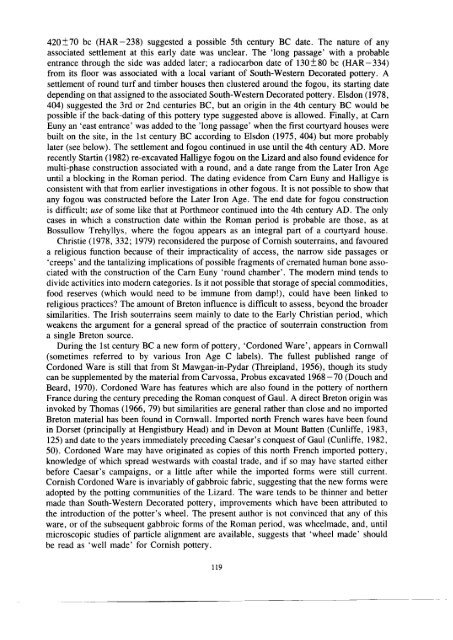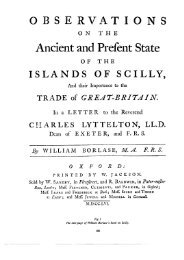Cornwall during the Iron Age and - Cornwall Archaeological Society
Cornwall during the Iron Age and - Cornwall Archaeological Society
Cornwall during the Iron Age and - Cornwall Archaeological Society
You also want an ePaper? Increase the reach of your titles
YUMPU automatically turns print PDFs into web optimized ePapers that Google loves.
420±70 be (HAR —238) suggested a possible 5th century BC date. The nature of any<br />
associated settlement at this early date was unclear. The 'long passage' with a probable<br />
entrance through <strong>the</strong> side was added later; a radiocarbon date of 130±80 be (HAR —334)<br />
from its floor was associated with a local variant of South-Western Decorated pottery. A<br />
settlement of round turf <strong>and</strong> timber houses <strong>the</strong>n clustered around <strong>the</strong> fogou, its starting date<br />
depending on that assigned to <strong>the</strong> associated South-Western Decorated pottery. Elsdon (1978,<br />
404) suggested <strong>the</strong> 3rd or 2nd centuries BC, but an origin in <strong>the</strong> 4th century BC would be<br />
possible if <strong>the</strong> back-dating of this pottery type suggested above is allowed. Finally, at Camn<br />
Euny an 'east entrance' was added to <strong>the</strong> 'long passage' when <strong>the</strong> first courtyard houses were<br />
built on <strong>the</strong> site, in <strong>the</strong> 1st century BC according to Elsdon (1975, 404) but more probably<br />
later (see below). The settlement <strong>and</strong> fogou continued in use until <strong>the</strong> 4th century AD. More<br />
recently Startin (1982) re-excavated Halligye fogou on <strong>the</strong> Lizard <strong>and</strong> also found evidence for<br />
multi-phase construction associated with a round, <strong>and</strong> a date range from <strong>the</strong> Later <strong>Iron</strong> <strong>Age</strong><br />
until a blocking in <strong>the</strong> Roman period. The dating evidence from Cam Euny <strong>and</strong> Halligye is<br />
consistent with that from earlier investigations in o<strong>the</strong>r fogous. It is not possible to show that<br />
any fogou was constructed before <strong>the</strong> Later <strong>Iron</strong> <strong>Age</strong>. The end date for fogou construction<br />
is difficult; use of some like that at Porthmeor continued into <strong>the</strong> 4th century AD. The only<br />
cases in which a construction date within <strong>the</strong> Roman period is probable are those, as at<br />
Bossullow Trehyllys, where <strong>the</strong> fogou appears as an integral part of a courtyard house.<br />
Christie (1978, 332; 1979) reconsidered <strong>the</strong> purpose of Cornish souterrains, <strong>and</strong> favoured<br />
a religious function because of <strong>the</strong>ir impracticality of access, <strong>the</strong> narrow side passages or<br />
'creeps' <strong>and</strong> <strong>the</strong> tantalizing implications of possible fragments of cremated human bone associated<br />
with <strong>the</strong> construction of <strong>the</strong> Cam Euny 'round chamber'. The modern mind tends to<br />
divide activities into modern categories. Is it not possible that storage of special commodities,<br />
food reserves (which would need to be immune from damp!), could have been linked to<br />
religious practices? The amount of Breton influence is difficult to assess, beyond <strong>the</strong> broader<br />
similarities. The Irish souterrains seem mainly to date to <strong>the</strong> Early Christian period, which<br />
weakens <strong>the</strong> argument for a general spread of <strong>the</strong> practice of souterrain construction from<br />
a single Breton source.<br />
During <strong>the</strong> 1st century BC a new form of pottery, 'Cordoned Ware', appears in <strong>Cornwall</strong><br />
(sometimes referred to by various <strong>Iron</strong> <strong>Age</strong> C labels). The fullest published range of<br />
Cordoned Ware is still that from St Mawgan-in-Pydar (Threipl<strong>and</strong>, 1956), though its study<br />
can be supplemented by <strong>the</strong> material from Carvossa, Probus excavated 1968 —70 (Douch <strong>and</strong><br />
Beard, 1970). Cordoned Ware has features which are also found in <strong>the</strong> pottery of nor<strong>the</strong>rn<br />
France <strong>during</strong> <strong>the</strong> century preceding <strong>the</strong> Roman conquest of Gaul. A direct Breton origin was<br />
invoked by Thomas (1966, 79) but similarities are general ra<strong>the</strong>r than close <strong>and</strong> no imported<br />
Breton material has been found in <strong>Cornwall</strong>. Imported north French wares have been found<br />
in Dorset (principally at Hengistbury Head) <strong>and</strong> in Devon at Mount Batten (Cunliffe, 1983,<br />
125) <strong>and</strong> date to <strong>the</strong> years immediately preceding Caesar's conquest of Gaul (Cunliffe, 1982,<br />
50). Cordoned Ware may have originated as copies of this north French imported pottery,<br />
knowledge of which spread westwards with coastal trade, <strong>and</strong> if so may have started ei<strong>the</strong>r<br />
before Caesar's campaigns, or a little after while <strong>the</strong> imported forms were still current.<br />
Cornish Cordoned Ware is invariably of gabbroic fabric, suggesting that <strong>the</strong> new forms were<br />
adopted by <strong>the</strong> potting communities of <strong>the</strong> Lizard. The ware tends to be thinner <strong>and</strong> better<br />
made than South-Western Decorated pottery, improvements which have been attributed to<br />
<strong>the</strong> introduction of <strong>the</strong> potter's wheel. The present author is not convinced that any of this<br />
ware, or of <strong>the</strong> subsequent gabbroic forms of <strong>the</strong> Roman period, was wheelmade, <strong>and</strong>, until<br />
microscopic studies of particle alignment are available, suggests that 'wheel made' should<br />
be read as 'well made' for Cornish pottery.<br />
119




